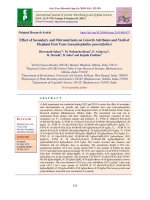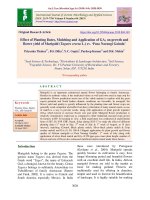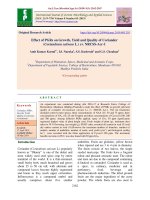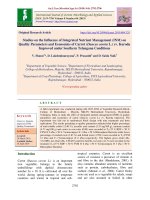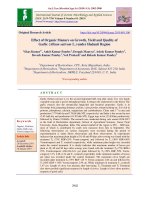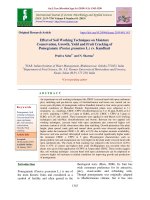Influence of biofertilizers and micronutrients on growth, seed yield and quality of coriander (Coriandrum sativum L.) cv. Sadhana
Bạn đang xem bản rút gọn của tài liệu. Xem và tải ngay bản đầy đủ của tài liệu tại đây (237.76 KB, 8 trang )
Int.J.Curr.Microbiol.App.Sci (2018) 7(1): 2099-2107
International Journal of Current Microbiology and Applied Sciences
ISSN: 2319-7706 Volume 7 Number 01 (2018)
Journal homepage:
Original Research Article
/>
Influence of Biofertilizers and Micronutrients on Growth, Seed Yield and
Quality of Coriander (Coriandrum sativum L.) cv. Sadhana
Y. Mounika*, G. Thanuja Sivaram, P. Syam Sundar Reddy and M. Ramaiah
College of Horticulture, Dr. YSR Horticultural University, Anantharajupeta -516 105,
YSR Dist. (A.P.), India
*Corresponding author
ABSTRACT
Keywords
Biofertilizers,
Micronutrients,
Seed yield, Quality
Article Info
Accepted:
16 December 2017
Available Online:
10 January 2018
A field experiment was conducted during rabi 2015-16 at Research Farm, College of
Horticulture, Dr. Y.S.R. Horticultural University, Anantharajupet (Andhra Pradesh), India,
to study the effect of biofertilizers and micronutrients on growth, seed yield and quality of
coriander (Coriandrum sativum L.) cv. Sadhana. The experiment was evaluated in
randomized block design with factorial concept consists two factors like biofertilizers and
micronutrients. The first factor comprised of seed inoculation with Azospirillum,
Phosphate solubilising bacteria, Azospirillum + Phosphate solubilising bacteria and control
(without any biofertilizer) and the second factor consists foliar spray of Zinc sulphate,
Copper sulphate, Ferrous sulphate each at @ 0.5% and control (without any
micronutrient). Sixteen treatment combinations were replicated thrice. Among the
treatments, seed inoculation with Azospirillum + Phosphate solubilising bacteria+ foliar
spray of zinc sulphate @ 0.5% recorded maximum plant height, number of primary
branches, number of secondary branches, days to maturity, number of umbels per plant,
umbellets per umbel, seeds per umbel, 100 seed weight, seed yield g per plant, seed yield
kg per hectare, Total carbohydrates, essential oils, oleoresins, moisture content. While, the
lowest Days to germination was maximum with seed inoculation of Azospirillum +
Phosphate solubilising bacteria + foliar spray of ferrous sulphate @ 0.5%.
Introduction
Coriander (Coriandrum sativum L.) is one of
the major seed spices grown in India. India is
the largest producer of coriander in the world
and is mainly cultivated in Rajasthan, Gujarat,
Andhra Pradesh, Madhya Pradesh, Tamil
Nadu, Orissa, Karnataka, Uttar Pradesh and
Bihar producing 52.4 million tonnes from 54.3
million hectares (NHB, 2013). Andhra
Pradesh ranks second in production of
coriander and ranks first in the Southern states
of the country. The share of Andhra Pradesh is
maximum i.e. 26,000 metric tonnes from
21,800 hectares (NHB, 2015). The coriander
seeds are rich in carbohydrate and protein
content. The aromatic nature of the plant is
due to the presence of an essential oil (terpene
tertiary alcohol i.e. linalool or coriandrol)
present in seeds and leaves. The oil is used in
perfumery, confectionery, cosmetics, for
flavouring liquors and beverages.
2099
Int.J.Curr.Microbiol.App.Sci (2018) 7(1): 2099-2107
The crop has to survive under residual soil
moisture throughout the cropping period and
generally experiences terminal moisture stress
which results in poor yields, which is the
major constraint in production of coriander in
Andhra Pradesh (Sarada et al., 2008). In
recent years, biofertilizers have emerged as an
important component of integrated nutrient
supply system and have shown promise to
improve crop yields and nutrient supplies.
Azotobacter, PSB and Azospirillum are the
most wide spread biofertilizers significantly
contributing N, P and K to plants and also
providing resistance to drought situation
(Maheshwari et al., 1991).
(Kalidasu et al., 2008) reported that foliar
application of micronutrients on crop growth
may be due to the improved ability of the crop
to absorb nutrients, photosynthesis and better
sink source relationship as these play vital role
in various biochemical processes. Information
regarding the use of biofertilizers and
micronutrients suitable for rain fed vertisols in
Andhra Pradesh is very meagre. Keeping this
in view, the present field experiment was
conducted to study the effect of biofertilizers
and micronutrients on growth, seed yield and
quality of coriander.
Materials and Methods
Present field experiment was conducted
during rabi 2015-16 at Research Farm,
College of Horticulture, Dr. Y.S.R.
Horticultural University, Anantharajupeta,
Andhra Pradesh (India).
inoculation with Azospirillum, B2M1- Seed
inoculation with PSB +foliar spray of ZnSO4
@0.5%, B2M2 -Seed inoculation with PSB
+foliar spray of FeSO4 @0.5%, B2M3 -Seed
inoculation with PSB + foliar spray of CuSO4
@0.5%, B2M4 - Seed inoculation with PSB,
B3M1-Seed inoculation with Azospirillum +
PSB + foliar spray of ZnSO4 @0.5%, B3M2 Seed inoculation with Azospirillum + PSB +
foliar spray of FeSO4 @0.5%, B3M3 -Seed
inoculation with Azospirillum + PSB + foliar
spray of CuSO4 @ 0.5%, B3M4-Seed
inoculation with Azospirillum + PSB, B4M1Foliar spray of ZnSO4 @ 0.5%, B4M2- Foliar
spray of FeSO4 @ 0.5 %, B4M3 - Foliar spray
of CuSO4 @0.5%, B4M4 - Control. Seeds were
sown in the plot of 2 m × 2m at spacing of 20
cm × 15 cm. The crop was fertilized with 10 t
of FYM along with NPK @ 30: 40: 20 kg/ha
as basal.
Two third of nitrogen was applied as top
dressing in two equal splits i.e. at 20 and 40
DAS. Need based cultural and plant protection
operations were taken up to the seed harvest.
Five plant samples from each replication were
selected at random to record data
morphological, yield and quality attributing
characters. The experimental data was
analysed statistically by the method of
analysis of variance as out lined by Panse and
Sukhatme (1995).
Results and Discussion
Growth parameters
Morphological characters
The experiment was laid out in randomized
block design with factorial concept triplicate
with sixteen treatments, viz., B1M1- Seed
inoculation with Azospirillum + foliar spray of
ZnSO4 @0.5%, B1M2 -Seed inoculation with
Azospirillum + foliar spray of FeSO4 @0.5%,
B1M3- Seed inoculation with Azospirillum +
foliar spray of CuSO4 @0.5%, B1M4- Seed
Morphological characters such as plant height,
number of primary branches per plant (Table
1), secondary branches per plant and days to
maturity (Table 2) showed significant
variation with different biofertilizers and
micronutrients.
2100
Int.J.Curr.Microbiol.App.Sci (2018) 7(1): 2099-2107
Height of plant
Among the biofertilizers, seed inoculation
with Azospirillum + Phosphate solubilising
bacteria recorded highest plant height at
harvest (70.78 cm), number of primary
branches at harvest (6.72), secondary branches
per plant (15.51) and lowest days to maturity
(96.75). Days to germination (Table 1) of
coriander seed was significantly influenced by
seed treatment with biofertilizers.
Manna et al., (2014) and Acharya et al.,
(2015) in onion. Combination of biofertilizers
and micronutrients on seed inoculation with
Azospirillum + Phosphate solubilising
bacteria+ foliar spray of zinc sulphate @0.5%
B3M1 recorded significantly highest plant
height at harvest (73.85cm), number of
primary branches at harvest (6.99), secondary
branches per plant (15.80) and lowest days to
maturity (95.25).
Yield and yield attributes
As the application of micronutrients was postemergence of the crop, the micronutrient
effect
and
the
interaction
between
biofertilizers and micronutrients application
were non- significant.
This might be due to Azospirillum and
phosphate solubalizing bacteria that help to
increase the nitrogen availability. Balanced or
integrated nutrient management which
enhances the synthesis of the carbohydrates,
phytohormones and even biofertilizers also
promote maximum growth of crop and build
up organic status of the soil that also increases
the availability of other nutrients.
The results are in conformity with those of
Sahu et al., (2014) in coriander.
Among different micronutrients, foliar
application of zinc sulphate @0.5 % (M1)
recorded significantly highest plant height at
harvest (70.45cm), number of primary
branches at harvest (6.35), secondary branches
per plant (15.29) and lowest days to maturity
(97.29).
This might be due to the involvement of Zn in
protein synthesis and in biosynthesis of plant
hormones by activating tryptophan, which is a
precursor of IAA (auxin), a growth harmone,
involved in cell division and cell elongation
which in turn promotes the vertical growth of
the plant. The results are in conformity with
those of Choudhary et al., (2014) in garlic,
The yield and yield attributing characters,
such as Number of umbels per plant (Table 2),
umbellets per umbel, seeds per umbel, 100
seed weight (Table 3), seed yield g per plant
and seed yield kg per hectare (Table 4) were
also showed significant variation among the
different biofertilizers and micronutrients.
Among the biofertilizers, seed inoculation
with Azospirillum + Phosphate solubilising
bacteria recorded maximum Number of
umbels per plant (26.83), umbellets per umbel
(6.56), seeds per umbel (35.49), 100 seed
weight (1.63), seed yield g per plant (5.00)
and seed yield kg per hectare (1196.75 kg).
It is obvious that availability of P improved by
PSB, N taped from atmosphere by
Azospirillum and soil was already have
sufficient amount of K leads to balance supply
of major nutrients and ultimately contributed
to higher yield and yield attributing characters.
These results are in agreement with those
reported by Belimov et al., (1995) in barley.
Among different micronutrients, foliar
application of zinc sulphate @0.5 % (M1)
recorded significantly maximum Number of
umbels per plant (24.77), umbellets per umbel
(6.41), seeds per umbel (32.11), 100 seed
weight (1.60), seed yield g per plant (4.91)
and seed yield kg per hectare (1149.90 kg).
2101
Int.J.Curr.Microbiol.App.Sci (2018) 7(1): 2099-2107
Table.1 Effect of biofertilizers and micronutrients on days to germination, Plant height (cm) at harvest and Number of primary
branches at harvest of coriander cv. Sadhana
Days to germination
Micronutrients
M1
M2
M3
M4
Mean
Source
S. Em ±
CD (P=0.05)
B1
7.38
7.96
7.65
7.41
7.48
B
0.05
0.29
B2
7.71
7.40
7.25
7.65
7.50
B3
6.88
7.00
7.65
8.00
7.57
M
0.05
NS
B4
7.38
7.25
8.25
8.85
7.93
Mean
7.40
7.41
7.83
7.85
B×M
0.10
NS
Plant height (cm) at harvest
Biofertilizers
B1
B2
B3
B4
70.25 70.25 73.85 65.48
62.28 69.68 72.23 63.68
63.45 68.45 71.28 65.28
61.28 61.48 69.35 60.38
64.32 68.83 70.78 63.71
B
M
B×M
0.43
0.43
0.86
1.24
1.24
2.48
Number of primary branches at harvest
Mean
70.45
67.34
66.72
63.12
B1
6.52
6.56
6.25
6.23
6.39
B
0.04
0.12
B2
6.54
6.10
6.35
5.40
6.10
B3
B4
6.99 5.35
6.56 5.85
6.98 5.30
6.35 5.15
6.72 5.41
M
B×M
0.04
0.08
0.12
0.23
Mean
6.35
6.27
6.22
5.78
Table.2 Effect of biofertilizers and micronutrients on Number of secondary branches at harvest, Days to maturity and Number of
umbels per plant of coriander cv. Sadhana
Number of secondary branches at harvest
Micronutrients
M1
M2
M3
M4
B1
15.54
15.28
14.75
14.52
B2
14.65
14.26
14.18
14.07
B3
15.80
15.58
15.55
15.38
B4
15.18
13.29
13.00
12.98
Mean
15.09
14.29
15.51
13.61
Source
S. Em ±
CD (P=0.05)
B
0.09
0.27
M
0.09
0.27
Mean
15.29
14.60
14.37
14.24
B×M
0.18
0.54
B1
97.65
98.25
96.85
99.00
97.94
B
0.65
1.88
Days to maturity
Biofertilizers
B2
B3
B4
97.00 95.25 99.25
96.65 96.23 99.65
98.25 96.86 99.89
99.25 98.65 110.0
0
97.79 96.75 102.2
0
M
B×M
0.65
1.30
1.88
3.77
2102
Number of umbels per plant
Mean
97.29
97.70
97.96
101.73
B1
23.25
22.13
21.72
21.52
B2
24.08
24.00
24.80
24.97
B3
28.80
27.25
26.01
25.26
B4
22.93
21.65
21.42
20.22
22.16
24.46
26.83
21.56
B
0.15
0.44
M
0.15
0.44
B×M
0.30
0.88
Mean
24.77
23.76
23.49
22.99
Int.J.Curr.Microbiol.App.Sci (2018) 7(1): 2099-2107
Table.3 Effect of biofertilizers and micronutrients on Number of umbellets per umbel, seeds per umbel and 100 seed weight of
coriander cv. Sadhana
Number of umbellets per umbel
Micronutrients
Number of seeds per umbel
100 seed weight
Biofertilizers
M1
M2
B1
6.29
6.14
B2
6.30
6.29
B3
6.85
6.65
B4
6.18
6.08
Mean
6.41
6.29
B1
30.00
27.53
B2
31.69
30.00
B3
38.73
36.81
B4
28.00
25.63
Mean
32.11
29.99
B1
1.55
1.48
B2
1.50
1.58
B3
1.80
1.72
B4
1.40
1.30
Mean
1.60
1.52
M3
6.10
6.31
6.40
5.95
6.19
26.20
32.15
34.21
23.61
29.04
1.45
1.49
1.65
1.39
1.46
6.02
6.14
6.34
6.31
6.35
6.56
M
0.12
0.04
5.86
6.02
6.14
24.53
27.07
32.18
31.51
32.19
35.49
M
0.19
0.54
23.00
27.98
25.06
B×M
0.38
1.09
1.38
1.47
B
0.01
0.03
1.42
1.54
1.29
1.35
B×M
0.02
0.06
1.39
M4
Mean
Source
S. Em ±
CD (P=0.05)
B
0.12
0.04
B×M
0.24
0.08
B
0.19
0.54
1.48
1.63
M
0.01
0.03
Table.4 Effect of biofertilizers and micronutrients on seed yield g per plant, seed yield kg per hectare and carbohydrates content (%)
of coriander cv. Sadhana
Seed yield g per plant
Micronutrient
B1
s
4.80
M1
4.24
M2
4.36
M3
4.28
M4
4.42
Mean
Source
S. Em ±
CD (P=0.05)
B2
B3
B4
Mean
4.96
4.68
4.20
4.15
4.50
B
0.03
0.08
5.82
5.00
4.80
4.37
5.00
4.08
3.98
3.70
3.25
3.75
M
0.03
0.08
4.91
4.47
4.26
4.01
B1
1238.68
1236.25
1220.28
1000.96
1174.04
B×M
0.06
0.17
Seed yield kg per hectare
Biofertilizers
B2
B3
B4
1100.25
1060.35
1050.48
1020.21
1057.82
B
7.00
20.22
2103
1270.38
1244.68
1241.78
1030.17
1196.75
M
7.00
20.22
Carbohydrates (%)
990.25
980.85
976.68
970.65
979.61
Mean
B1
1149.90
1130.53
1126.30
1005.50
22.67
21.21
20.20
20.68
21.19
B
0.13
0.38
B×M
14.00
40.44
B2
B3
B4
23.01 25.45 17.29
21.69 24.20 16.25
22.00 23.09 18.06
19.65 20.00 14.02
21.61 23.17 16.41
M
B×M
0.13
0.26
0.38
0.76
Mean
22.13
20.84
20.82
18.59
Int.J.Curr.Microbiol.App.Sci (2018) 7(1): 2099-2107
Table.5 Effect of biofertilizers and micronutrients on essential oil (%), oleoresins (%) and moisture (%) of coriander cv. Sadhana
Essential oil (%)
Micronutrients
M1
M2
M3
M4
Mean
Source
S. Em ±
CD (P=0.05)
B1
0.85
0.84
0.86
0.70
0.81
B2
0.91
0.89
0.85
0.69
0.83
B
0.01
0.02
B3
0.96
0.91
0.92
0.75
0.89
M
0.01
0.02
B4
0.74
0.70
0.72
0.68
0.71
Mean
0.87
0.84
0.84
0.71
B×M
0.02
0.04
B1
0.72
0.65
0.62
0.60
0.66
Oleoresins (%)
Biofertilizers
B2
B3
B4
0.73
0.80
0.50
0.61
0.76
0.48
0.66
0.75
0.42
0.58
0.70
0.40
0.65
0.75
0.45
B
M
0.004
0.004
0.011
0.011
2104
Moisture (%)
Mean
0.70
0.63
0.61
0.57
B×M
0.008
0.02
B1
9.50
9.36
8.95
10.19
9.50
B2
B3
9.00
8.15
10.01 8.65
10.19 8.38
10.25 8.75
9.86
8.48
B
M
0.07
0.07
0.19
NS
B4
10.52
10.81
10.68
10.98
10.75
B×M
0.13
NS
Mean
9.29
9.71
9.55
10.04
Int.J.Curr.Microbiol.App.Sci (2018) 7(1): 2099-2107
Interaction effect of biofertilizers and
micronutrients on seed inoculation with
Azospirillum + Phosphate solubilising
bacteria+ foliar spray of zinc sulphate @0.5%
B3M1 recorded significantly maximum
Number of umbels per plant (28.80),
umbellets per umbel (6.85), seeds per umbel
(38.73), 100 seed weight (1.80), seed yield g
per plant (5.82) and seed yield kg per hectare
(1270.38 kg).
Quality characters
With regards to quality characters, such as
carbohydrate content (Table 4), essential oil
content oleoresins content and moisture
content (Table 5) were also showed
significant variation among the different
biofertilizers and micronutrients. Among the
biofertilizers,
seed
inoculation
with
Azospirillum + Phosphate solubilising
bacteria recorded maximum carbohydrate
content (23.17%), essential oil content
(0.89%), oleoresins content (0.75%) and
lowest moisture content (8.48%). Similar
observation was recorded by Rahimi et al.,
(2009), Sahu et al., (2012) in coriander crop.
Among different micronutrients, foliar
application of zinc sulphate @0.5 % (M1)
recorded significantly maximum carbohydrate
content (22.13%), essential oil content
(0.87%), oleoresins content (0.70%) and
lowest moisture content (9.29%).
The positive effect of zinc with respect to
plant vegetative growth and yield with its
attributes and quality is due to the fact that
zinc favours the enzyme system, auxin and
protein synthesis and seed production directly
or indirectly. Zn improves photosynthesis and
assimilates transportation to sinks and finally
increased oleoresin contents.
Interaction effect of biofertilizers and
micronutrients on seed inoculation with
Azospirillum + Phosphate solubilising
bacteria+ foliar spray of zinc sulphate @0.5%
B3M1 recorded significantly maximum
carbohydrate content (25.45%), essential oil
content (0.96%), oleoresins content (0.80%)
and lowest moisture content (8.15%).
References
Acharya, U., N.S. Rimal, K. Venkatesan, T.
Saraswathi, K.S. Subramanian 2015.
Response on growth, yield and quality
parameters of Multiplier Onion (Allium
cepa L.var aggregatum Don.) var CO5
with different doses and method of Zinc
and Boron application. Intl. J. Agron.
Agr. Res., 6(4): 59-67.
Belimov, A.A., A.P. Kojemiakov and C.V.
Chuvarliyeva 1995. Interaction between
barley and mixed cultures of nitrogen
fixing and phosphate - solubilising
bacteria. Plant and Soil, 173: 29-37.
Choudhary, M.K., A. Kavita, I.B., Maurya, B.
Singh, M.K., Sharma and P.K., Hatwal
2014. Effect of biofertilizers and
micronutrients on growth and yield of
garlic (Allium sativum L.) var. ‘G-282’.
Prog. Hort., 46(2): 1-21.
Kalidasu, G., C. Sarada and Y.T., Reddy
2008. Influence of micronutrients on
growth and yield of coriander
(Coriandrum sativum) in rain fed
vertisols. J. Spi. and Aro. Cro, 17 (2):
187-189.
Maheshwari, S.K., S.K. Gangreede and K.C.
Trived 1991. Comparative responses of
palmarosa to Azotobacter and nitrogen
under rainfed and irrigated swards.
Indian. Perf., 35(2): 108-111.
Manna, D., T.K. Maity and A, Ghosali 2014.
Influence of foliar application of boron
and zinc on growth, yield and bulb
quality of onion (Allium cepa L.) J. Cro.
W., 10(1): 53-55.
National Horticulture Board, 2013. Area and
Production statistics of Horticulture
2105
Int.J.Curr.Microbiol.App.Sci (2018) 7(1): 2099-2107
Crops. Ministry of Agriculture,
Government of India.
National Horticulture Board, 2015. Area and
Production statistics of Horticulture
Crops. Ministry of Agriculture,
Government of India.
Panse, V.G. and P.V. Sukhatme 1995.
Statistical Methods for Agricultural
Workers. 4th Ed, I C A R, New Delhi. 1347.
Rahimi, A.R., K, Mashayekhi, S, Amini, E.
Soltani 2009. Effect of Mineral vs.
Biofertilizer on the Growth, Yield and
Essential Oil Content of Coriander
(Coriandrum sativum L.) Medi. Aro.
Pla. Sci. Biol., Global Science Books.
Sahu, R.L., P.K. Kashyap and D. Upadhyay
2012. Investigation of Bio-fertilizers
Influence on Physiological and Yield
Contributing Characters of Coriander
(Coriandrum sativum L.) Indian. Hort.
J., 2 (3-4): 75-77.
Sahu, R.L., S. Hansa and S. Kumar 2014.
Effect of application of inorganic
fertilizers and biofertilizers on growth
components and yield traits of coriander
(Coriandrum sativum L.) Pro. Hort., 46
(1).
Sarada, C., K. Giridhar and T. Yellamanda
Reddy 2008. Effect of bio-regulators
and their time of application on growth
and yield of coriander (Coriandrum
sativum) J. Spi. Aro. Cro., 17: 183-186.
How to cite this article:
Mounika, Y., G. Thanuja Sivaram, P. Syam Sundar Reddy and Ramaiah, M. 2018. Influence of
Biofertilizers and Micronutrients on Growth, Seed Yield and Quality of Coriander
(Coriandrum sativum L.) cv. Sadhana. Int.J.Curr.Microbiol.App.Sci. 7(01): 2099-2107.
doi: />
2106
